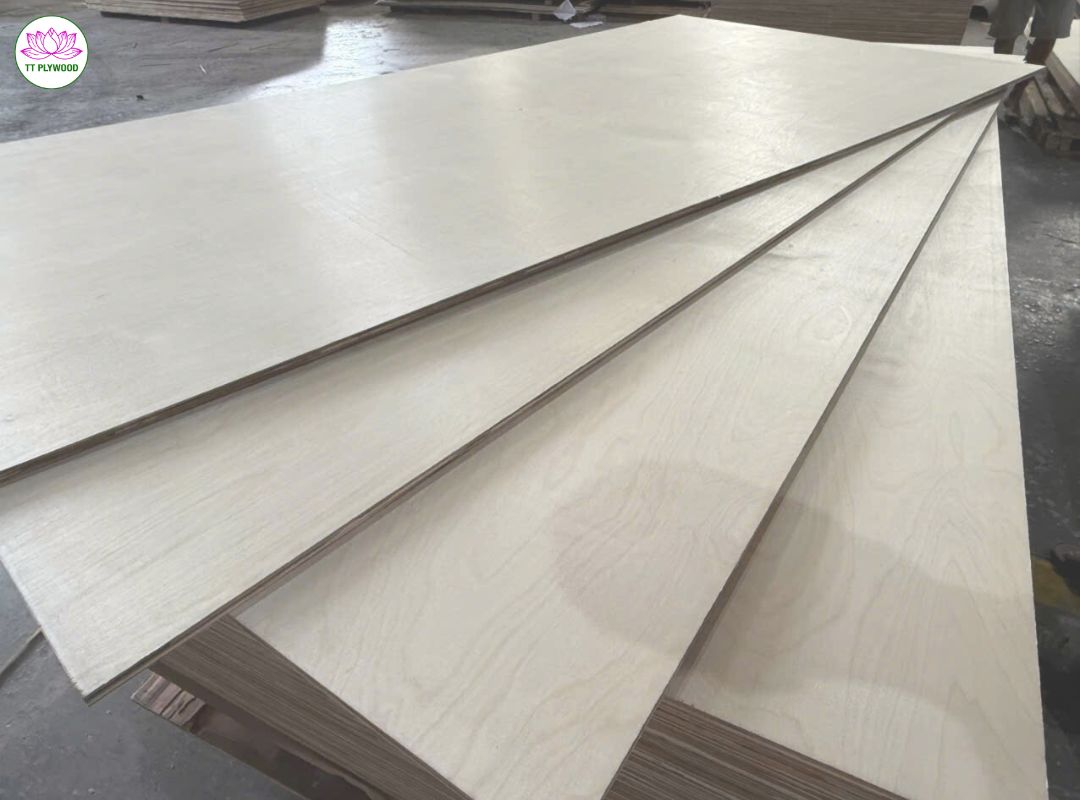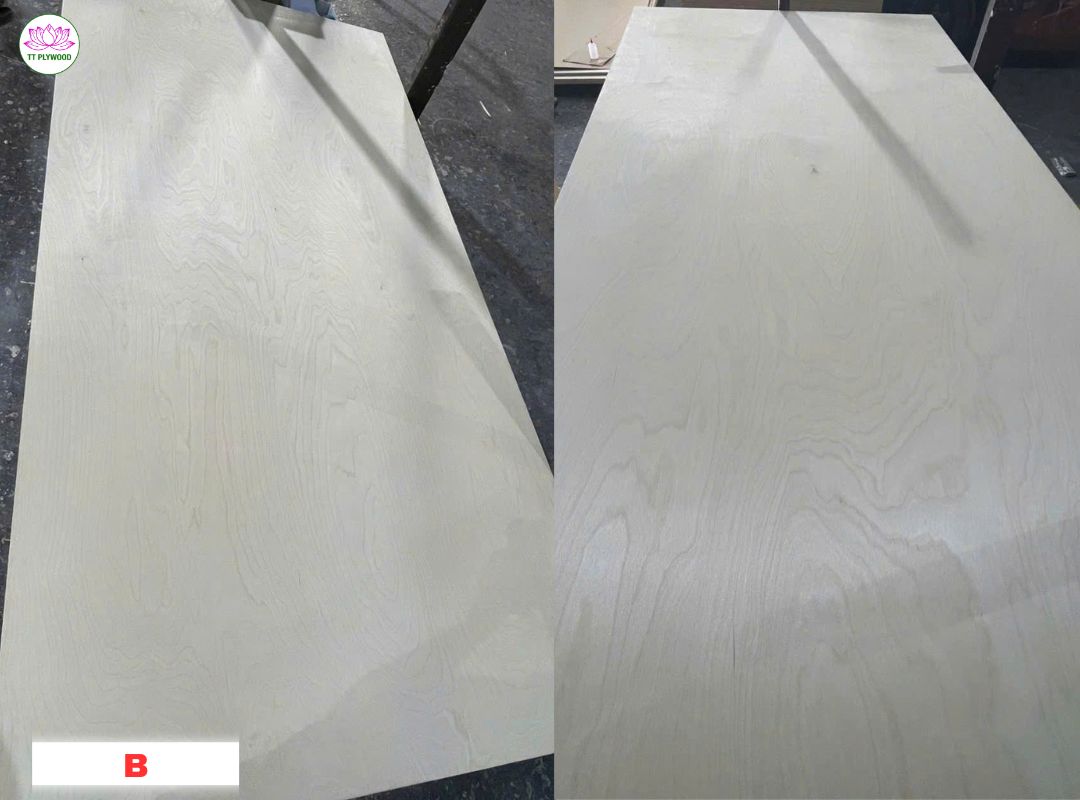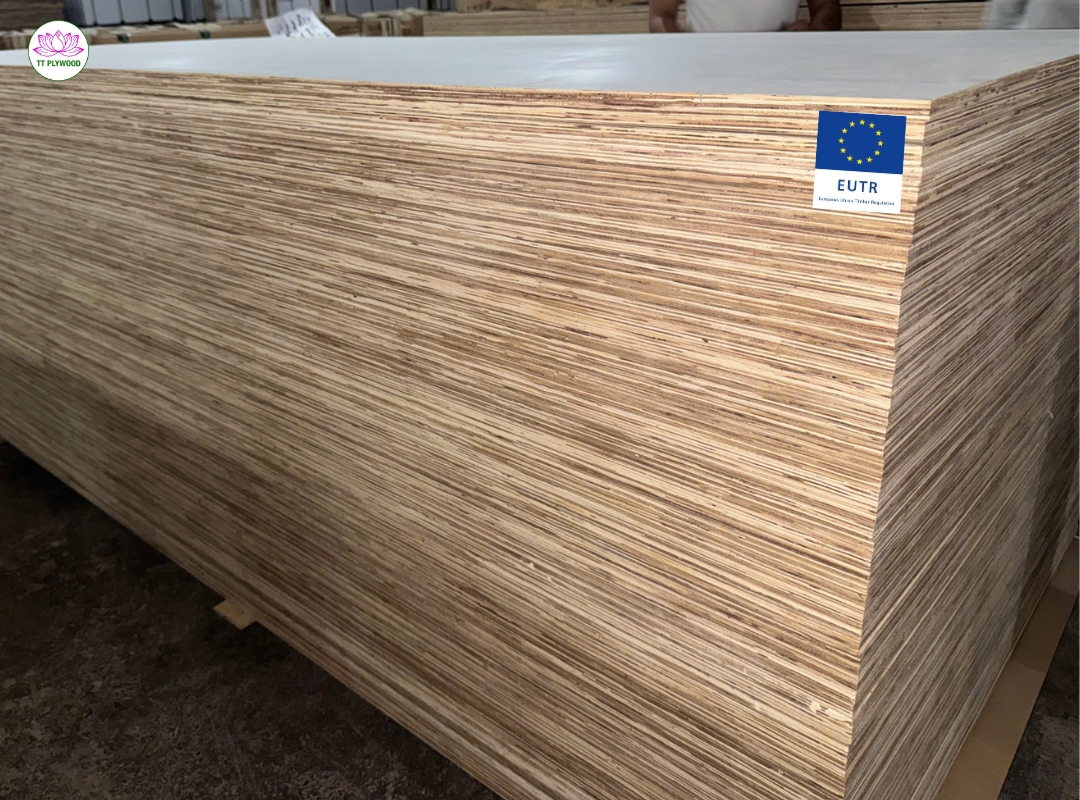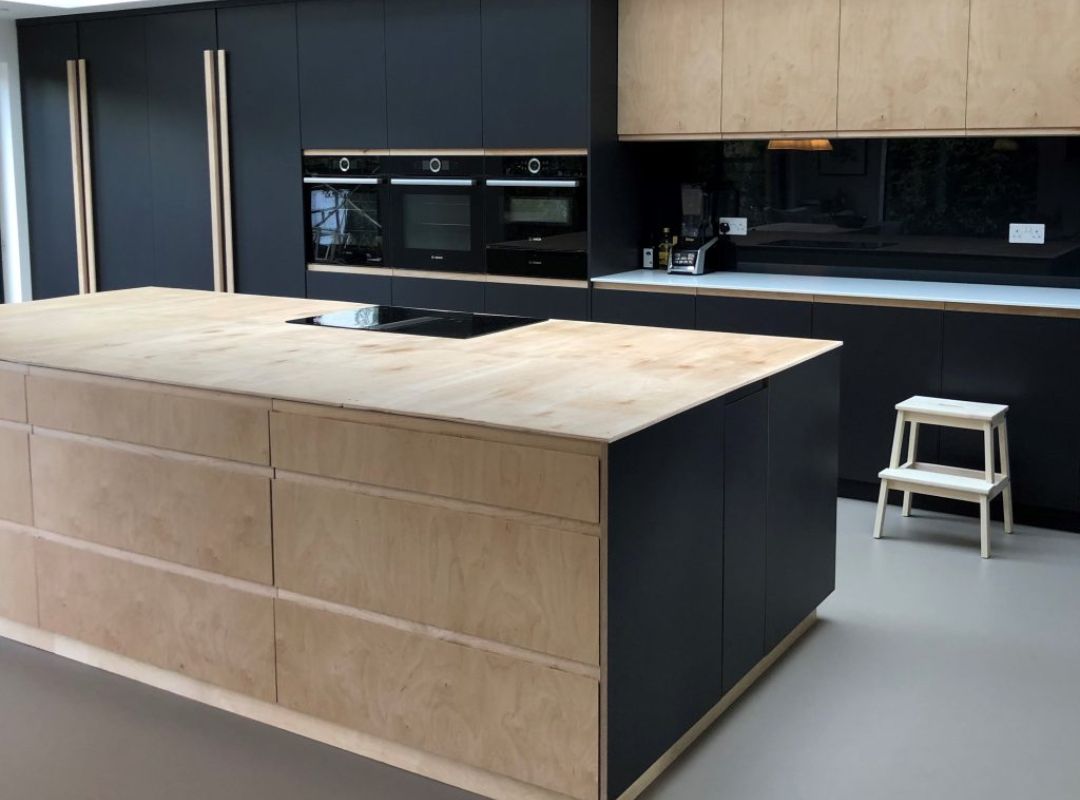-
-
-
Total payment:
-

Birch Plywood Sizes: 2440×1220mm Standards and Custom Options for 2025
Posted by Thanh Uyên at 13/11/2025
1. Why 2440×1220mm Birch Plywood Still Leads in 2025
The 2440×1220 mm (8×4 ft) birch plywood sheet has become the “universal language” of panel sizing in global trade. From US cabinet makers to European CNC workshops, this format fits most saws, CNC beds, panel saws, and packaging lines. It reduces offcuts, simplifies nesting layouts, and makes logistics planning easier.

(Birch Plywood - 100% Rubbercore - TT Plywood)
For importers who want an overview of how birch plywood is produced and positioned in Vietnam specifically, one of the best starting points is the article “Birch Plywood in Vietnam”.
For a quick visual and commercial snapshot, you can also refer to TT Plywood’s LinkedIn update about Vietnamese birch, project photos, and export routes:
As markets shift away from Russian and some Chinese sources, Vietnamese mills are taking over more of the 2440×1220 birch plywood segment – both in standard sheets and cut-to-size programs.
2. Basic Size and Thickness Standards for 2440×1220mm
When buyers talk about “standard birch,” they mostly mean 2440×1220 mm in a few common thicknesses. Typical thickness ranges include 3 mm, 6 mm, 9 mm, 12 mm, 15 mm, 18 mm, 21–24 mm. Some factories also offer intermediate thicknesses such as 7 mm, 10 mm or 16 mm for special projects or regional norms.
Length and width are usually maintained within a tolerance of about ±2 mm, while diagonal differences are controlled to avoid “rhombus” panels that can cause fitting issues in cabinetry or flooring. For most professional applications especially CNC – thickness tolerance is just as important as nominal thickness. Well-calibrated mills in Vietnam are capable of achieving thickness tolerance in the range of ±0.15–0.2 mm on standard birch plywood, which makes edge-banding and precision joinery more predictable.
This is particularly relevant for buyers in the US who work with nested-based CNC operations. TT Plywood’s dedicated cut-to-size birch program is detailed here:
“Birch Plywood Cut-to-Size – Fast Delivery to the US (FSC Certified)”
3. How Global Standards Define Birch Plywood Quality
Beyond physical size, different regions use different formal standards to define birch plywood quality, especially for 2440×1220 mm panels used in structural and decorative roles.

(Birch Plywood B Grade - 100% Rubbercore)
In Europe, EN 636 and EN 314-2 define durability class and bond quality, while EN 635 specifies face grades such as E, B, S or A/B, B/BB, BB/BB for birch. These documents set out what buyers can expect in terms of veneer repairs, knot size, sanding quality, and allowable patches.
In North America, structural performance is regulated under PS 1–19, with further guidance from APA and HPVA. For birch plywood used in furniture and interiors, grading schemes like B/BB, BB/BB or CP/CP are common. They indicate how “clean” the visible faces are, which matters for cabinetry, wall panels, and exposed furniture parts.
Japan has its own JAS standards, with strict moisture and bonding requirements, especially for humid or seismic environments. Even when the panel size is identical (2440×1220), these standards influence which end markets the plywood can legally or practically be used in.
As buyers move away from Baltic sources, many have been comparing technical and visual performance of Vietnamese birch against traditional Russian birch. A useful deep dive on that point is:
“Vietnamese Birch Plywood – The Best Alternative to Baltic Birch (2025 Guide)”
4. Core Construction and Its Impact on Stability
Two sheets of birch plywood can share the same outer dimensions and still behave differently if their cores are built differently. Core design has a major impact on flatness, screw-holding power, and long-term stability.
Full birch core is generally considered the premium option: it offers excellent density, high internal bond, and strong fastener-holding capacity. Combi cores, where birch faces are combined with eucalyptus, poplar or rubberwood inner plies, offer a good balance between performance and price. Full eucalyptus cores are extremely strong and dense, often used for flooring substrates or industrial applications. Rubberwood-based hybrids can be a smart option for interior furniture where sustainability and weight reduction are priorities.
In all cases, a well-made 2440×1220 panel should present a dense, even core on the cross-section, without large voids or open gaps between veneers. Properly calibrated hot pressing and consistent veneer thickness ensure size stability and reduced risk of warping during machining or installation.
5. Standard vs Custom Sizes: How Fabricators Are Changing the Game

(Birch Plywood - Acacia Core)
Historically, most importers only ordered full 2440×1220 sheets and did their own cutting. In 2025, more and more US and EU fabricators are shifting to factory-cut birch plywood, either in half sheets, narrow strips, or fully CNC-processed blanks.
Common examples include 1220×1220 mm half panels for small workshops, 2440×600 mm or 2440×300 mm strips for kitchen carcasses, or bespoke pieces sized to fit cabinet modules and drawer banks. This helps reduce waste in high-wage countries and transfers the cutting work to locations where labor and electricity costs are lower.
Vietnam has become particularly strong in this field because mills can integrate panel production, sanding, calibration and sawing in a single workflow, and then containerize ready-to-assemble packages for direct use in overseas factories.
6. Vietnam’s Strategic Role in 2440×1220mm Birch Plywood
Vietnam’s rise as a birch plywood supplier is not accidental. It is driven by a mix of policy, forestry, and industrial capability. The country has invested heavily in plantation forestry (eucalyptus, acacia, rubberwood), modern veneer peeling lines, and hot-press calibration systems. At the same time, trade routes from Hai Phong and Ho Chi Minh City ports are well established toward the US West Coast, East Coast, and European hubs like Rotterdam and Koper.
For birch plywood specifically, many Vietnamese plants import birch veneer while using local hardwood cores. This hybrid model enables them to keep costs under control while delivering a surface quality similar to traditional Baltic birch. When combined with FSC certification and E0/E1 or CARB P2 formaldehyde compliance, Vietnamese birch becomes a strong choice for importers who need both performance and regulatory peace of mind.
7. Customs, Documentation, and Size-Related Issues
For most customs authorities, the 2440×1220 size itself is not a problem. What matters is the HS code, declared composition, certification status, and whether the product falls under any anti-dumping or environmental scrutiny.
However, there are some size-related practical issues that importers should remember. Oversize sheets, for example 2500×1250 mm or 2800×1220 mm, may require special handling or may not fit standard pallet and container patterns. In contrast, 2440×1220 mm fits perfectly into most container loading configurations and can be palletized efficiently.
From a customs documentation perspective, importers should ensure that the declared thicknesses and grades match what is physically shipped, especially when using a mix of standard and custom formats in one container. In some markets, birch plywood is also subject to closer examination under timber legality legislation, which makes clear documentation from the mill even more important.
8. Typical Applications of 2440×1220mm Birch Plywood Today

In 2025, 2440×1220 mm birch plywood panels are used in a wide spectrum of applications. Cabinet shops rely on them for carcasses, drawers, and painted fronts. CNC studios turn them into furniture kits, acoustic wall panels, fixtures, and signage. Flooring companies use them as stable substrates under finished floors. Van and RV converters value birch plywood for its strength-to-weight ratio and clean appearance. Industrial packagers use it to build durable crates and pallets for high-value equipment.
Because one single size format can feed so many different sectors, the 2440×1220 birch sheet has become a sort of “universal blank” for modern fabrication.
9. Why Many Importers Now Prefer Vietnamese Birch Over Baltic
For decades, Baltic birch was the default answer to any birch plywood requirement. That landscape has changed after trade restrictions, sanctions, and supply disruptions. Vietnamese birch plywood has emerged as a realistic and often preferable alternative for three main reasons: availability, flexibility, and compliance.
First, Vietnamese mills are able to maintain steady production and shorter lead times to both US and EU ports. Second, they are often more flexible about customization: thickness adjustments, special grading, or ready-to-assemble cut sizes. Third, they actively pursue FSC and low-emission certifications that align with new European and North American regulations.
Together, these factors explain why more international buyers are shifting frame orders and long-term contracts from Baltic sources to Vietnamese suppliers.
10. Secure Your 2440×1220 Birch Supply
If you are looking for reliable sources of 2440×1220 mm birch plywood, cut-to-size solutions, or FSC-certified material for high-end furniture, CNC work or industrial use, TT Plywood can help.
The company focuses on export-grade birch plywood with:
- Standard and custom thicknesses
- Full and combi-core options
- FSC and CARB-compliant glue systems
- Cut-to-size and CNC-ready blanks
To discuss specifications, pricing, or trial loads:
📩 Email: info@ttplywood.com
📞 WhatsApp / Zalo: +84 32 694 2288
🌐 Website: ttps://ttplywood.com
Frequently Asked Questions (FAQ)
Q1. Is 2440×1220mm the same as 8×4 ft?
Yes. 2440×1220 mm is the metric equivalent of 8×4 ft and is widely used as the standard plywood size globally.
Q2. Can I mix standard 2440×1220 sheets and custom-cut sizes in one container?
Yes. Many Vietnamese mills can load both full sheets and cut-to-size panels in the same shipment, as long as packing and documentation are planned correctly.
Q3. Are thickness tolerances tight enough for CNC use?
High-quality lines can achieve ±0.2 mm or better, which is suitable for precision CNC and edge-banding.
Q4. Is Vietnamese birch plywood accepted as an alternative to Baltic birch?
For most furniture, cabinetry and CNC projects, yes. Many importers have already switched and report comparable performance with more stable pricing.
Q5. Can TT Plywood support FSC-certified projects?
Yes. FSC-certified options are available on request, together with appropriate paperwork for EU and US audits.
12. References
APA – The Engineered Wood Association (2023). Plywood Design and Application Guide. Tacoma, WA: APA.
European Commission (2024). EN 636 and EN 314-2: Structural Plywood Standards and Bonding Requirements. Brussels: EU Publications.
FSC (2024). Global Market Trends for FSC-Certified Plywood and Engineered Wood. Bonn: Forest Stewardship Council.










